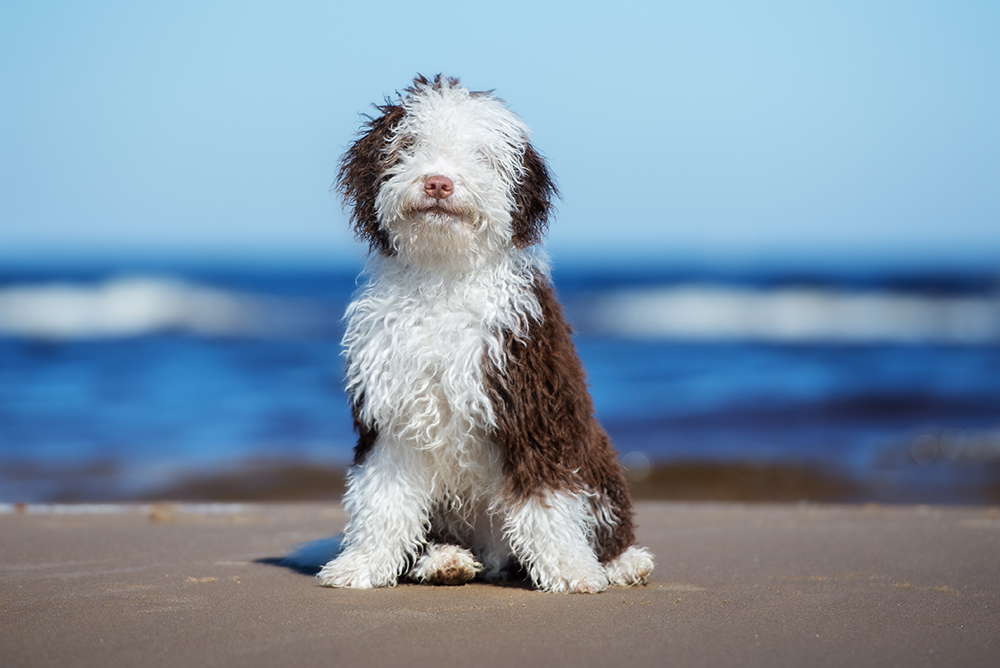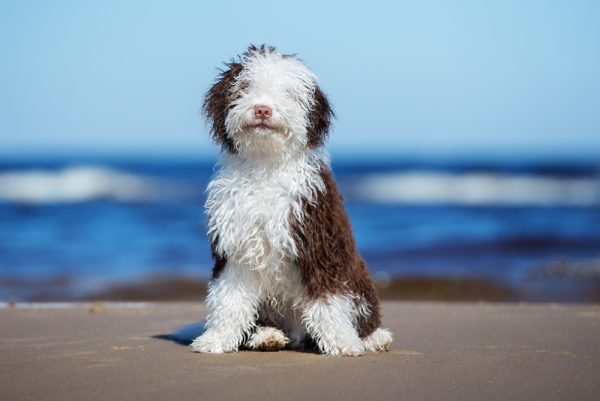Click to Skip Ahead
The Spanish Water Dog is a spirited dog with a strong work ethic. They have a seemingly endless supply of energy and are intelligent dogs who are ready to face any challenge that comes their way. Their skill sets and temperaments make them excellent companions for people with active lifestyles or those who are looking for a canine farmhand.
Due to their high need for physical exercise and mental stimulation, Spanish Water Dogs are typically recommended for more experienced dog owners who can invest a significant amount of time in training. Here’s what you can expect life with a Spanish Water Dog to look like and if this breed is a good fit for you.
Breed Overview
Height:
15–20 inches
Weight:
30–50 pounds
Lifespan:
12–14 years
Colors:
Beige, black, brown, white
Suitable for:
Active families, outdoorsy lifestyles, dog training enthusiasts, rural homes
Temperament:
Energetic, cheerful, playful, hardworking
Spanish Water Dogs are medium-sized working dogs. They were originally bred for herding and retrieving, but they’re quite versatile and can be found working in a variety of settings. Spanish Water Dogs are quick learners and confident in their abilities. They’re trustworthy and reliable dogs that take pride in their work and take their responsibilities seriously.
Spanish Water Dog Characteristics

Spanish Water Dog Puppies
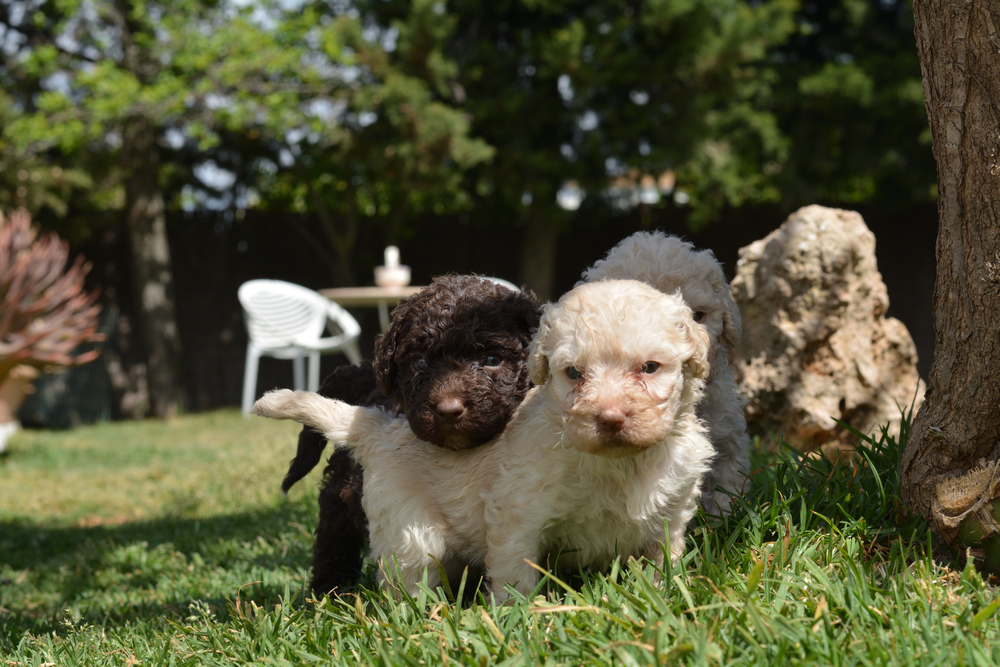
Spanish Water Dogs aren’t very common in the US, and it can be challenging to find breeders near you. You can start your search by looking for breeders registered with the Spanish Water Dog Club of America1 or the American Kennel Club (AKC) Marketplace.2 Some dog rescue organizations may have Spanish Water Dogs available and ready for adoption, but it’s more likely that they’ll have adult dogs than puppies.
Spanish Water Dog puppies seem to have an endless supply of energy. They love to play, run, and chase things and are extremely curious. It’s important to puppy-proof your home thoroughly, as Spanish Water Dog puppies will be able to get into every nook and cranny of the house. They’ll also benefit from crate training because they often can’t be left unsupervised until they’ve been completely housebroken.
Sticking to a daily routine can make life easier for both Spanish Water Dog puppies and their owners. Spanish Water Dogs are smart and quick to pick up on a schedule. Knowing what to anticipate can help with anxiety and keep dogs in a calmer state. Routines can also strengthen your bond with your puppy as your puppy learns to trust and rely on you to get their needs met.
Spanish Water Dogs have a guarding side to them, and they tend to be wary of strangers. Therefore, early socialization is a top priority when raising a Spanish Water Dog puppy. Make sure to introduce them to a variety of friendly people to help them build positive associations and learn how to interact with others appropriately. The same goes for other dogs and new environments. Keep initial interactions short and fun to prevent your puppy from feeling overwhelmed.
Spanish Water Dog Origin & History
The Spanish Water Dog is an old dog breed that’s been living alongside humans for centuries. It’s widely believed that they arrived in the Iberian Peninsula with Turkish traders sometime during the 10th century. Being highly versatile, Spanish Water Dogs were employed to do different kinds of work, including retrieving waterfowl and herding livestock.
While the Spanish Water Dog has existed for a long time, the breed only started gaining popularity in Spain during the 1970s. They recently received official recognition by the AKC in 2015.

Temperament & Intelligence of the Spanish Water Dog
Spanish Water Dogs have a set of qualities and strengths that make them excellent workers. They have a lot of energy and stamina, and they’re very intelligent. Spanish Water Dogs are proud of their jobs and love being entrusted with a responsibility.
Spanish Water Dogs don’t really outgrow their puppy energy and will remain high-energy dogs well into their adulthood. While they’re fast learners and eager to please, they’re not always recommended for first-time dog owners because they can still be a handful. They require a significant amount of daily physical and mental exercise. Therefore, they often match well with individuals who enjoy dog training and participating in dog sports, such as agility courses and herding events.
While Spanish Water Dogs take their responsibilities seriously, they have a playful side to them. It’s as if they have different energy reserves for work and play. After working, they have a fresh burst of energy and are ready to spend the rest of the day having fun with their humans. They can be a little aloof with strangers, but they’re affectionate with their families and love being included in all family activities. They love human companionship and don’t do well being left alone for long hours.
Are These Dogs Good for Families? 👪
Spanish Water Dogs can be good family dogs. However, their highly energetic and active lifestyles may be too overwhelming for small children. Young Spanish Water Dogs may accidentally knock over small children while they’re running and playing.
As herding dogs, some Spanish Water Dogs can also develop a habit of herding young children and trying to corral them. Therefore, both dogs and children need to learn how to interact with each other respectfully. Early socialization will help Spanish Water Dogs immensely with getting used to children and understanding how to play with them safely. For the most part, children match well with a Spanish Water Dog’s playfulness, and they usually grow to become each other’s playmates and companions.
Does This Breed Get Along With Other Pets? 🐶 😽
Spanish Water Dogs are perfectly content with being the only dog in the home. However, they can still get along with other pets in the house. It’s important to make introductions between pets a slow and gradual process. Spanish Water Dogs may need some time to get used to other pets, but they can usually learn to leave them alone and respect their space.
While Spanish Water Dogs can live harmoniously with other pets in the home, they don’t tend to be social with other dogs outside of the family. Taking the time to socialize Spanish Water Dogs properly will help prevent them from being highly reactive or timid around other dogs.
Things to Know When Owning a Spanish Water Dog:
Food & Diet Requirements 🦴
Spanish Water Dogs usually do just fine with eating high-quality dog food. Working Spanish Water Dogs may benefit from eating a high-protein diet that can supply more energy for their active lifestyles. Older Spanish Water Dogs may need bone and joint supplements added to their diet as they become more prone to hip dysplasia and arthritis.
The breed is predisposed to exocrine pancreatic insufficiency (EPI), which can cause malabsorption of nutrients and digestive issues. Therefore, it’s important to stay on top of routine exams so that your veterinarian can determine if your Spanish Water Dog is getting all their nutritional needs met. Some Spanish Water Dogs may have sensitive stomachs and can benefit from eating dog food with a sensitive skin and stomach formula.
It’s important to discuss your Spanish Water Dog’s diet with your veterinarian at their annual check-ups. Your veterinarian can help you track your dog’s weight and recommend any specific diets that match your dog’s unique needs.
Exercise 🐕
An important thing to know about Spanish Water Dogs is that they require both physical and mental exercise every day. Spanish Water Dogs have a lot of energy and can even seem inexhaustible at times. They often require a minimum of 1 hour of physical exercise a day. They’ll enjoy going on brisk morning walks, but they’ll benefit most from being able to let loose and run around freely. Therefore, they need to be in homes that have a securely fenced yard or in rural homes where there’s plenty of land for them to run around. Spanish Water Dogs are also excellent retrievers and can usually pick up on fetching balls and catching frisbees pretty quickly.
Spanish Water Dogs need mental stimulation and must have enrichment activities scheduled into their daily routine. They’ll love solving dog puzzles and learning new games like hide-and-seek or sniffing out treats hidden throughout the home. Learning new tricks and participating in dog sporting events can also keep Spanish Water Dogs happy and healthy.
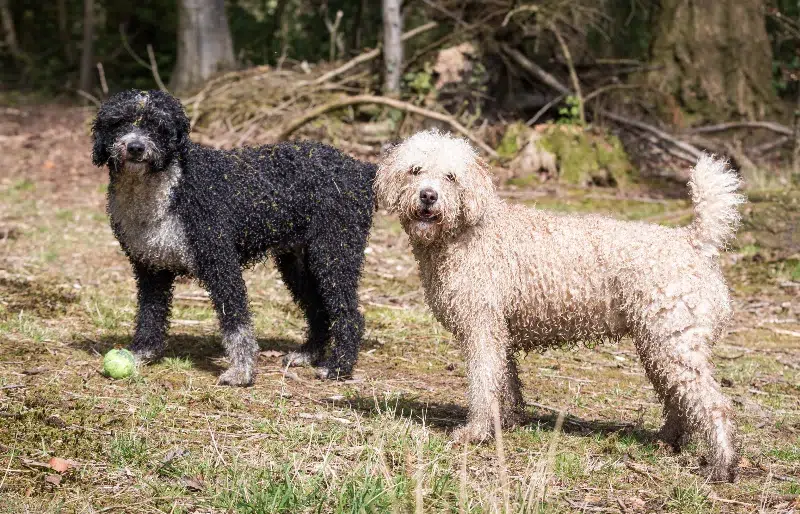
Training 🎾
Spanish Water Dogs are very smart and eager to please. This combination makes them enthusiastic learners that are relatively easy to train. When training a young Spanish Water Dog, you may notice that they’re easily distracted. Exercising your Spanish Water Dog and expending a little of their energy before a training session can help them stay focused. It’s also helpful to keep training sessions short and fun and schedule many short sessions all throughout the day. This style of training will keep Spanish Water Dogs engaged and help them retain what they’re learning.
It’s important to note that Spanish Water Dogs are lifelong learners. They love puzzles and challenges, and many develop a hobby of learning new tricks. They’re capable of having an extensive repertoire of tricks and often excel in agility and herding events.
Grooming ✂️
Spanish Water Dogs have unique coats that form cords when they’re grown out. In some sense, Spanish Water Dogs have low grooming needs because it’s recommended not to brush their coats. However, they do have grooming needs that are different from most dog breeds. Most Spanish Water Dog owners will shave their dogs’ coats annually to a shorter length and allow their hair to form natural cords. The cords can be trimmed several times throughout the year to help keep them more manageable. It’s also important to check their coats regularly for any matting and to remove them gently with your fingers.
Spanish Water Dogs should only be bathed when necessary. You can use dog wash wipes to spot-clean and wipe away patches of dirt that get on their coats. When it’s time to bathe them, use a mild shampoo, and avoid 2-in-1 varieties that contain conditioning ingredients. Rather than massaging the shampoo into the coat, shampoo should be squeezed through the coat to avoid matting. Instead of rubbing with a towel, blot and squeeze excess water from their coats with a towel to dry them. Allow their coats to air dry, and never blow them out.
Due to having long, floppy ears, Spanish Water Dogs are prone to getting ear infections. Their ears can trap moisture easily and provide ideal conditions for bacterial growth. Therefore, make sure to check their ears regularly and keep them clean and dry by using an ear cleanser.
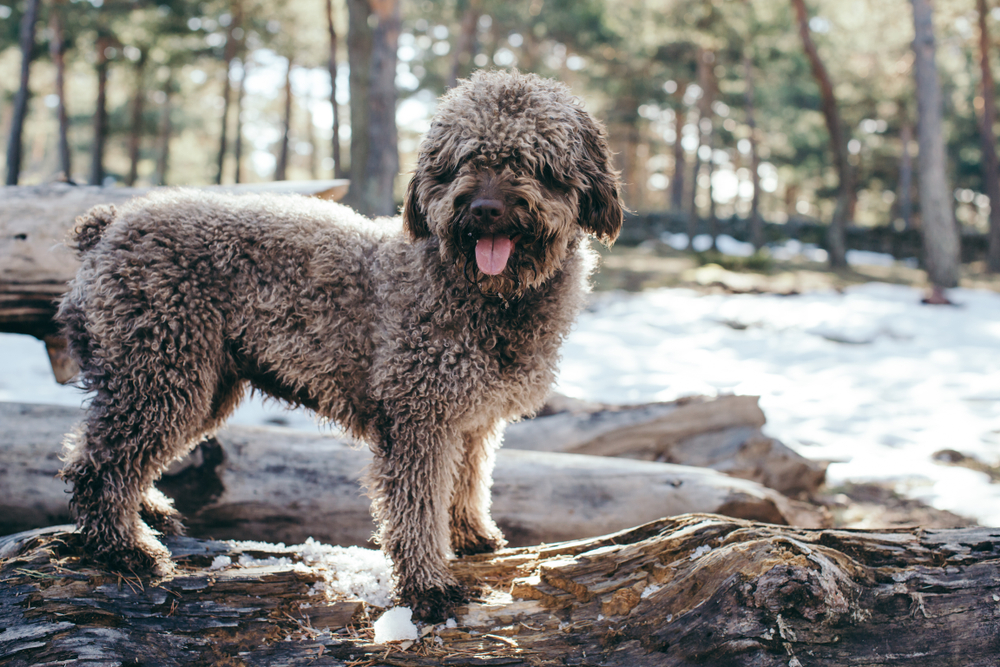
Health and Conditions 🏥
Spanish Water Dogs are generally healthy dogs. However, as a purebred dog, they’re prone to certain genetic conditions as they age. Spanish Water Dogs are susceptible to the following health issues.
- Hip dysplasia
- Sensitive stomach
- Ear infections
- Exocrine pancreatic insufficiency (EPI)
- Glaucoma
Male vs Female
Male and female Spanish Water Dogs are nearly indistinguishable at first glance. Males may grow a little larger and weigh more than females, but their temperaments are fairly the same. Some males may have a bit more stamina than females, but both are still very energetic.
You’re more likely to notice more behavioral differences between dogs that have or haven’t been spayed or neutered. Dogs that haven’t undergone this surgery will display mating behavior, while spayed and neutered dogs are less likely. They can act more aggressive and territorial, and they’re more prone to wandering and escaping in search of a mate. They may also engage in more urine marking, and females’ moods can shift throughout their estrus cycle.
3 Little-Known Facts About the Spanish Water Dog
1. The Spanish Water Dog has many names.
Spanish Water Dogs are often mistaken for Poodles, Portuguese Water Dogs, or Lagotto Romagnolos. It doesn’t help that they also go by several other names. They’re also known as Perro de Agua Español, Turco Andaluz, Perro Turco, and Andalucian Turk.
2. Spanish Water Dogs are adaptable to job changes.
Spanish Water Dogs were originally bred as herders and retrievers. However, they’re actually very adaptable and versatile workers, and you can see how their roles have changed with the Industrial Revolution in Spain.
When more people moved to cities and didn’t rely as much on hunting dogs for food, Spanish Water Dogs adapted well to taking on work in more urban settings. Today, you can see them in search and rescue work, drug and bomb detection, and other active jobs that require a lot of brains and stamina.
3. The breed was revived in 1975.
The Spanish Water Dog population declined as the need for hunting dogs and herding dogs decreased. Fortunately, the breed was preserved through the initial efforts of Santiago Montesinos and Antonio Garcia Perez in 1975. Breeding programs worked diligently to preserve the breed’s original appearance and temperament. Spanish Water Dogs were officially recognized by the Real Sociedad Central de Fomento de Razas Caninas en España in 1985 and by the Federacion Cinologica Internacional (FCI) several years later.

Final Thoughts
Spanish Water Dogs form strong bonds with their families and love spending all day with their favorite people. They’re hard workers who want to do a good job in everything that they do. They’re also intelligent dogs who love figuring out challenges and learning new things. Therefore, Spanish Water Dogs are best for people who can invest a significant amount of time and energy into channeling their energy into productive activities, such as dog sports or herding livestock.
When Spanish Water Dogs are cared for properly, they become some of the most devoted and loyal companions. Earning their trust and respect is certainly rewarding and worth the effort, and you’ll end up with a trustworthy, reliable friend with a lot of love to give.
Featured Image Credit: otsphoto, Shutterstock

